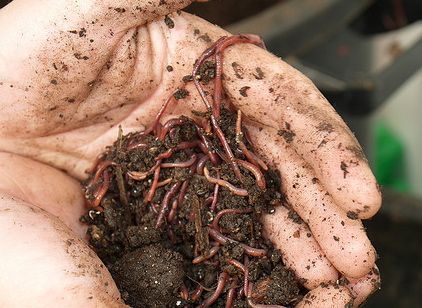
Photo by D_S_O.
I’m worried about my worms.
It’s not that they aren’t thriving, mind you. The little guys slither about in what I imagine must be a happy manner whenever I lift the lid of the vermicompost bin for a weekly feeding. I introduced the lot to my apartment last August, so they’ve had plenty of time to settle in. I imagine members of my worm community pairing off, buying their own patches of dirt, and raising worm families. I wouldn’t be surprised if a few of the skinny, lethargic ones are teenage offspring going through their James Dean phases.
It’s the harvesting part that has me worried. That is, I need to get the dirt out without losing (or killing) my worms.
When I started the bin, my bedding of choice was coir — coconut fibers that expand like the dickens in water. The dirt-colored, fluffy coir makes fantastic annelid bedding because it holds moisture well, and the worms can even snack on it in a pinch. But now, eight months in, most of the coir has been replaced with rich, woodsy-smelling black dirt: the ultranutritious plant food we call compost.
Vermicompost is, of course, worm poop, the output from my regular inputs of banana peels and sweet-potato skins. And wonderful as this poop may be, living in a bed of one’s own filth is never ideal. According to one of my favorite worm husbandry guides, it’s not healthy for the squirmers to live in an environment where the compost-to-bedding ratio is too high. When a bin reaches the state mine has, it’s time to harvest the compost and freshen up the bedding for round two.
The task at hand: Separate the worms from the compost so you can mulch that stuff all over town. There’s an easy way and a hard way to do this. In the hard version, you spread a huge plastic tarp across the floor in a sunny room and dump the contents of your bin on top. The worms will dive to the pile’s darkest depths like a bunch of wriggling vampires, leaving the top layers free for the taking. Scoop, wait, repeat until you’ve harvested most of the compost and created a concentrated ball of worms on your tarp. Plop ‘em back in a fresh bin, and the cycle begins anew. The whole process takes a whole day or two.
Lucky for me, I have the idiotproof variety of worm bin — the one made with stacking trays. When one tray fills with Black Gold, the worms migrate up to the next one. But I also have one problem: The compost is ready, but it hovers a few inches from the top of the first tray, making the great worm parade to tray two impossible.
Should I wait until the worms manage to fill the tray? Or should I throw them a bone and add some more coir to make up the difference? Wouldn’t that screw up the pH? I need answers. Luckily, in its balls-out bid for the Crunchiest City in America title, Seattle keeps a worm consultant on hand for conundrums such as these.
No, seriously. My consultant, Laura Matter, works for the Tilth Garden Hotline. I got her number off of the Seattle government website [PDF]. Clearly trained for circumstances like these, Matter is all business when I call for advice. “What does the tray look like now?” she asks. When I describe the compost, she gives me her blessing to fill in the tray with more coir.
As it’s not every day you get your own worm consultant on the phone, I also ask Matter’s opinion on bedding types. Besides coir, you’ve got the option of using ripped-up leaves, newspaper, shredded secret internal memos (“Insider trading documents, officer? Well, they certainly aren’t spread over my gardenias!”), or actual manure. “Coir works really well,” she agrees. Good, because, really, where would I get my hands on a horse at such short notice?
I pick up a few bricks of coir at a local garden center for $2 each and rehydrate them in our trash can. After 30 minutes or so, the fibers have plumped up enough to go into the bin. I fill my first tray, put the second tray on top, and add the rest of the coir. I have to augment the top tray with shredded newspaper to fill it out, but my new worm development project is open for business. I decide I’ll feed them a particularly alluring mixture of strawberry tops and avocado peel tomorrow to lure them up.
Matter had warned me that it can take up to a month for all the worms to pull up stakes and move into the new tray (there’s bound to be some food or remnant bedding in the first tray to hold them back for a while). So I’m surprised, and proud, when I open the lid the next day to find several enterprising individuals already making themselves at home. “Good for you guys!” I tell the pioneers, giving them first dibs on the latest meal. Looks like my teen worms have shaken off their angst and struck out to make a name for themselves in the brave new world.
Three weeks have passed since then, and the great vertical exodus continues. There are still some stubborn worms making their last stand in the first tray, but I’m confident that the lot will move north soon and their luscious compost will be ripe for the taking. If not? Don’t worry — I’ve got a personal worm consultant on speed dial.


